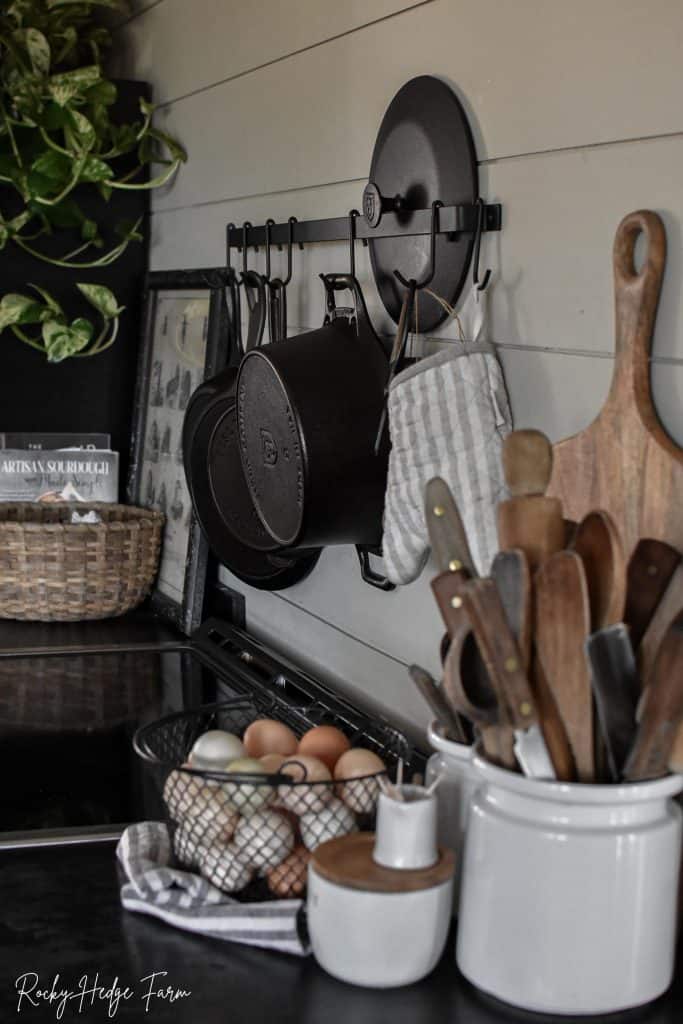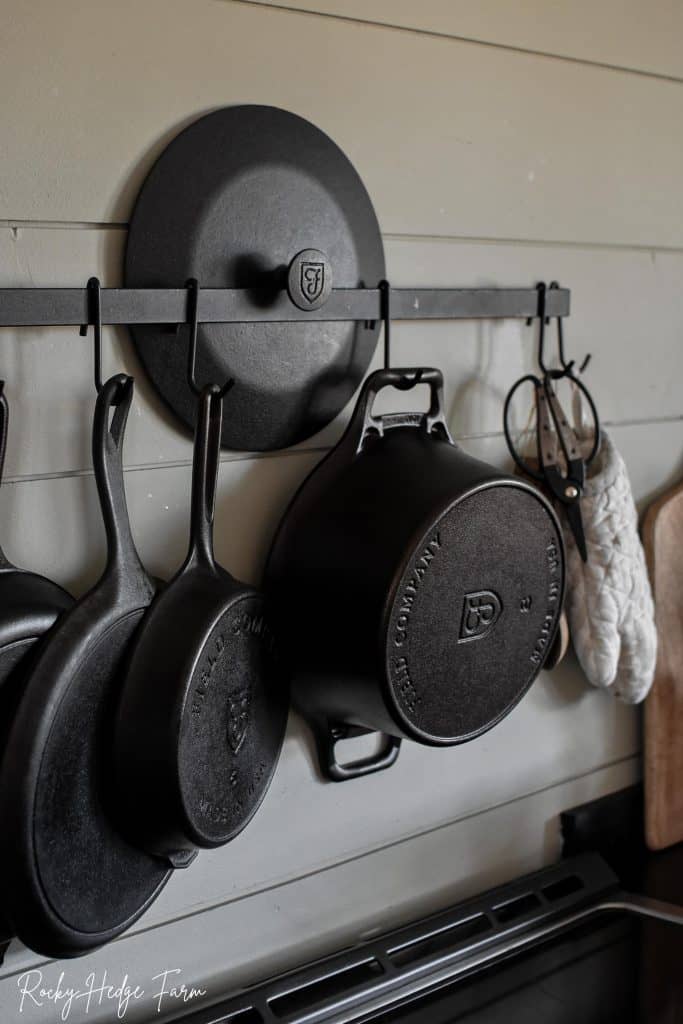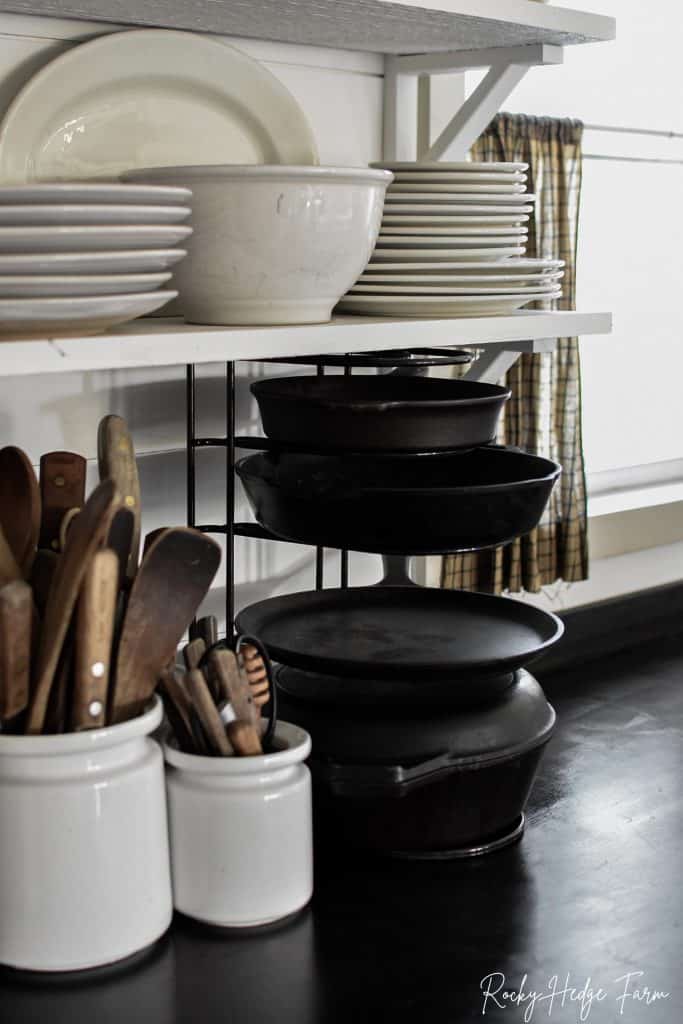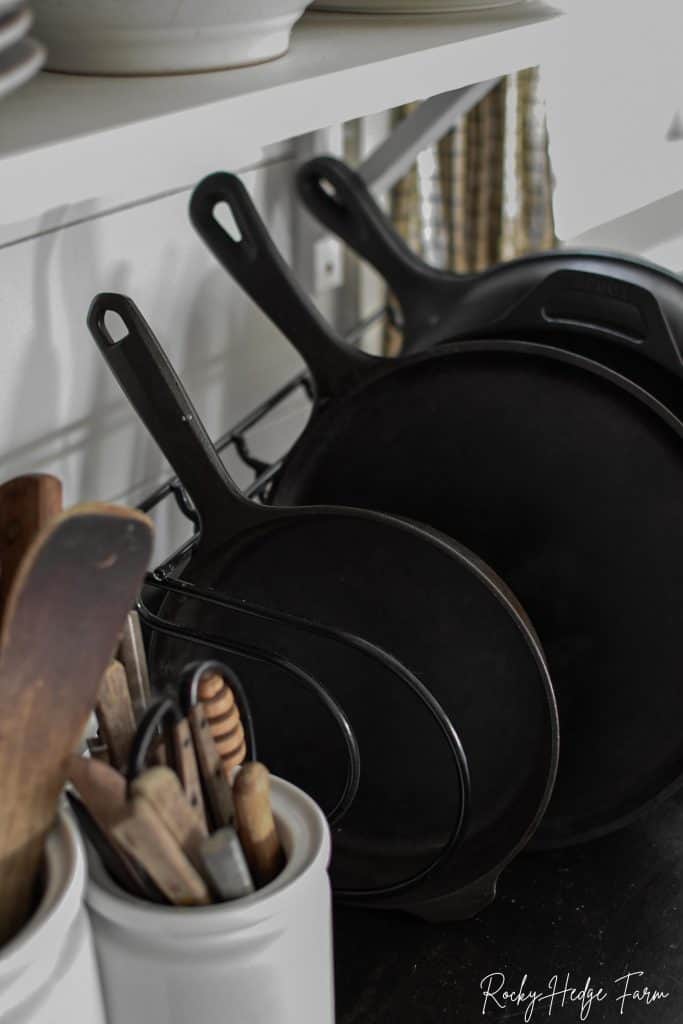Guide to Storing Cast Iron Pans: Tips for a Lifetime of Use
Properly storing cast iron pans is key to maintaining their durability, performance, and longevity. After years of cooking with cast iron, I’ve found that this type of cookware is unmatched in its versatility, resilience, and timeless appeal. But keeping cast iron pans in top shape requires a few extra steps, especially regarding storage.
Whether you’re new to cast iron or have a growing collection, here’s everything you need to know about storing cast iron pans—from preventing rust to keeping them ready for everyday use.

Why Proper Cast Iron Storage Matters
While cast iron is known for its toughness, it’s also prone to rust if not properly maintained. Storing cast iron correctly extends its life, keeps it seasoned, and ensures it’s always ready for the next meal. The good news? You can keep your cast iron in excellent condition with simple steps and storage tips.
Kitchen Tools (affiliate links): Cast Iron Skillets | Seasoning Oil
How to Store Cast Iron Pans: Essential Steps for Optimal Care
Step 1: Clean Your Cast Iron After Every Use
Before storing your cast iron, it’s crucial to clean it well after each use. Cleaning prevents food from sticking and reduces the chance of rust forming. Here’s a quick cleaning process:
- Remove Food Residue: Use a scraper or brush to remove any food residue after cooking.
- Rinse with Warm Water: Avoid soap if possible, as it can strip away the seasoning layer. Instead, use warm water and a brush to rinse the pan.
- Avoid Soaking: Cast iron should never be left soaking, as prolonged contact with water can lead to rust.
Step 2: Dry the Cast Iron Pan Completely
One of the most common causes of rust is moisture left on the surface. Dry your cast iron thoroughly after washing:
- Use a Towel: Pat the pan dry with a clean towel to absorb any visible moisture.
- Stovetop Drying: Place the pan on a burner over low heat for a few minutes to ensure it’s entirely dry. The heat helps evaporate any lingering water and reduces the risk of rust.
Step 3: Apply a Thin Layer of Oil
Oiling your cast iron after drying is essential to prevent oxidation and maintain the seasoning. Here’s how:
- Choose Your Oil: Select an oil suitable for cast iron or a specific cast iron seasoning oil.
- Use a Small Amount: Pour a small amount of oil onto a paper towel or clean cloth.
- Rub the Oil on All Surfaces: Apply a light coat to the inside, outside, and handle of the pan. Wipe away any excess to leave a matte finish, as too much oil can create a sticky residue.

The Best Ways to Store Cast Iron Pans
Depending on your kitchen setup, various ways to store cast iron safely and conveniently exist. Here are some of the best storage options:
1. Hang Cast Iron Pans on the Wall
Hanging cast iron pans is one of the most effective ways to store them, keeping them accessible and promoting airflow.
- Use a Wall Rack: A sturdy wall rack can hold several pans and make them easy to reach.
- Cast Iron Hooks: Heavy-duty hooks work well for individual pans. As cast iron is heavy, make sure to attach them securely.
- Avoid Overcrowding: Give each pan space to avoid scratching and promote airflow, reducing the chance of trapped moisture.


2. Use a Heavy-Duty Pan Organizer
A pan organizer can be a practical solution for those with more cabinet or counter space. These organizers are designed to hold cast iron pans without stacking them directly on each other, reducing wear and making pans easy to grab.
- Vertical or Horizontal Options: Some organizers can be stored vertically or horizontally, depending on your space.
- Size and Weight Considerations: Choose an organizer rated for heavy cookware to ensure it can support the weight of cast iron.


3. Stack with Caution
If space is limited and stacking is your only option, stack cast iron correctly.
- Use Paper Towels: Place a layer of paper towels or cloth between each pan to prevent scratching and help absorb moisture.
- Nest Smaller Pans Inside Larger Ones: Arrange pans by size, with smaller skillets nested inside larger ones. This minimizes the risk of damaging the seasoning.
- Avoid Overstacking: Only stack a few pans to prevent excessive weight on the lower pans.
4. Store on the Stovetop or Inside the Oven
Storing cast iron on the stovetop or inside the oven can be convenient if you have no other options.
- Stovetop Storage: Keep your go-to skillet on the stove for easy access and a dry environment. When cooking with other pans, just move it out of the way.
- Oven Storage: The oven provides a dry, safe storage area for less-used pieces. However, remember to remove them before preheating the oven.
Additional Cast Iron Care Tips for Long-Lasting Pans
Proper storage is just one part of cast iron care. Here are a few more tips to keep in mind:
- Seasoning: Regular seasoning prevents rust and creates a non-stick surface. A well-seasoned pan is easier to cook with and maintain.
- Use the Right Utensils: Metal utensils won’t harm a well-seasoned pan, but if you’re concerned about scratching, wooden tools are a safe bet.
- Avoid Drastic Temperature Changes: Going from a hot stove to cold water can cause thermal shock, which may crack cast iron. Allow the pan to cool slightly before cleaning.

Frequently Asked Questions about Cast Iron Storage
Should I Oil Cast Iron Before Storing?
Yes, a thin layer of oil protects the surface from rust and helps maintain the seasoning. Just be sure to wipe away excess oil to avoid a sticky finish.
Can I Dry Cast Iron on the Stove?
After cleaning, place the pan on low heat for a few minutes to dry thoroughly. This method removes any residual moisture that could lead to rust.
Essential Cast Iron Storage Accessories
To keep your cast iron in peak condition, consider these recommended storage items:
- Wall-Mounted Rack: Perfect for displaying cast iron on the wall, offering both functionality and style.
- Heavy-Duty Pan Organizer: Great for stacking pans in cabinets or on countertops.
- Cast Iron Hooks: Forged hooks designed for heavy-duty cookware, ideal for wall mounting.
The Final Word on Storing Cast Iron Pans
With proper care and storage, cast iron pans can last for generations, becoming more seasoned and cherished. Following these simple steps—cleaning, drying, oiling, and choosing the right storage solution—ensures your cast iron remains a kitchen staple for years.

About Sarah
Wife. Mother. From-Scratch Cook. Homemaker.
I’m Sarah, the creator of Rocky Hedge Farm, where I share my love for simple living, homemade meals, and creating a cozy home. As a wife and mother, I’m passionate about slowing down, cooking from scratch, and finding joy in the everyday moments of life. From DIY projects and family-friendly recipes, I hope to inspire others to embrace a life rooted in simplicity and warmth.






I love my cast iron skillets and use them daily. I heard to scrub them with salt when really nasty and then I rinse. It seems to work well. What do you think good or bad?
i love everything you post. youre a inspiration to homemakers, past and future !! thank you Sara